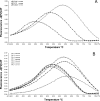High prevalence of human parvovirus B19 DNA in myocardial autopsy samples from subjects without myocarditis or dilative cardiomyopathy
- PMID: 19005147
- PMCID: PMC2620852
- DOI: 10.1128/JCM.01672-08
High prevalence of human parvovirus B19 DNA in myocardial autopsy samples from subjects without myocarditis or dilative cardiomyopathy
Abstract
Human parvovirus B19 has been linked to a variety of cardiac diseases, as well as to erythema infectiosum, acute arthropathy, and fetal hydrops. A causal association between viral infection and cardiac disease was frequently postulated following the detection of B19 DNA by PCR in endomyocardial biopsy specimens. Since the lifelong persistence of B19 DNA in bone marrow, skin, synovia, tonsils, and liver was previously reported, the aim of our study was to investigate the possibility of asymptomatic B19 DNA persistence in heart tissue. Myocardial autopsy and postmortem blood samples were prospectively collected from 69 bodies sent to the Department of Forensic Medicine, Freiburg University Medical Center, for inquests. All study subjects were screened for B19-specific antibodies using a commercial enzyme immunoassay. Tissue samples were analyzed by real-time PCR for the presence of viral DNA. Since the presence of B19 genotype 2, known to have been circulating before 1960, would prove long-lasting persistence, the presence of the B19 genotype was retrospectively determined in seven of the study subjects by melting temperature analysis and sequencing of the PCR product. B19 DNA was found in myocardial samples from 46 of 48 seropositive and in none of 21 seronegative individuals. B19 genotype 1 was found in three patients born between 1950 and 1969. Genotype 2 was found in four patients born between 1927 and 1957. Our findings suggest lifelong persistence of B19 DNA in heart tissue. Thus, the detection of B19 DNA in myocardial biopsy specimens alone is not sufficient to postulate a relationship between B19 infection and cardiac disease.
Figures

Comment in
-
Pathophysiological mechanisms of parvovirus B19 infection.J Clin Microbiol. 2009 Jul;47(7):2358-9; author reply 2359. doi: 10.1128/JCM.00580-09. J Clin Microbiol. 2009. PMID: 19574588 Free PMC article. No abstract available.
Similar articles
-
The presence of enterovirus, adenovirus, and parvovirus B19 in myocardial tissue samples from autopsies: an evaluation of their frequencies in deceased individuals with myocarditis and in non-inflamed control hearts.Forensic Sci Med Pathol. 2014 Sep;10(3):344-50. doi: 10.1007/s12024-014-9570-7. Epub 2014 Apr 30. Forensic Sci Med Pathol. 2014. PMID: 24781135
-
Myocardial parvovirus B19 persistence: lack of association with clinicopathologic phenotype in adults with heart failure.Circ Heart Fail. 2011 Jan;4(1):71-8. doi: 10.1161/CIRCHEARTFAILURE.110.958249. Epub 2010 Nov 19. Circ Heart Fail. 2011. PMID: 21097605 Free PMC article.
-
Prevalence of parvovirus B19 and human bocavirus DNA in the heart of patients with no evidence of dilated cardiomyopathy or myocarditis.Clin Infect Dis. 2009 Dec 1;49(11):1660-6. doi: 10.1086/648074. Clin Infect Dis. 2009. PMID: 19863443
-
Prevalence of parvovirus B19 infection in patients infected with human immunodeficiency virus.Clin Infect Dis. 1996 Dec;23(6):1255-60. doi: 10.1093/clinids/23.6.1255. Clin Infect Dis. 1996. PMID: 8953068 Review.
-
Human parvovirus B19: relevance in internal medicine.Neth J Med. 1999 Jun;54(6):221-30. doi: 10.1016/s0300-2977(99)00011-x. Neth J Med. 1999. PMID: 10399450 Review.
Cited by
-
Classification and histological, immunohistochemical, and molecular diagnosis of inflammatory myocardial disease.Heart Fail Rev. 2013 Nov;18(6):673-81. doi: 10.1007/s10741-012-9355-6. Heart Fail Rev. 2013. PMID: 23096264 Review.
-
Parvovirus B19 DNA detectable in hearts of patients with dilated cardiomyopathy, but absent or inactive in blood.ESC Heart Fail. 2021 Aug;8(4):2723-2730. doi: 10.1002/ehf2.13341. Epub 2021 May 1. ESC Heart Fail. 2021. PMID: 33931945 Free PMC article.
-
First report on severe septic shock associated with human Parvovirus B19 infection after cardiac surgery.Front Cell Infect Microbiol. 2023 Apr 5;13:1064760. doi: 10.3389/fcimb.2023.1064760. eCollection 2023. Front Cell Infect Microbiol. 2023. PMID: 37091672 Free PMC article.
-
Bones hold the key to DNA virus history and epidemiology.Sci Rep. 2015 Nov 27;5:17226. doi: 10.1038/srep17226. Sci Rep. 2015. PMID: 26611279 Free PMC article.
-
Seroepidemiology of parvovirus B19 in the Frankfurt am Main area, Germany: evaluation of risk factors.Infection. 2010 Oct;38(5):381-5. doi: 10.1007/s15010-010-0035-y. Epub 2010 Jun 17. Infection. 2010. PMID: 20556472
References
-
- Anand, A., E. S. Gray, T. Brown, J. P. Clewley, and B. J. Cohen. 1987. Human parvovirus infection in pregnancy and hydrops fetalis. N. Engl. J. Med. 316183-186. - PubMed
-
- Anderson, M. J., S. E. Jones, S. P. Fisher-Hoch, E. Lewis, S. M. Hall, C. L. Bartlett, B. J. Cohen, P. P. Mortimer, and M. S. Pereira. 1983. Human parvovirus, the cause of erythema infectiosum (fifth disease)? Lancet 11378. - PubMed
-
- Bultmann, B. D., K. Klingel, M. Nabauer, D. Wallwiener, and R. Kandolf. 2005. High prevalence of viral genomes and inflammation in peripartum cardiomyopathy. Am. J. Obstet. Gynecol. 193363-365. - PubMed
-
- Cassinotti, P., G. Burtonboy, M. Fopp, and G. Siegl. 1997. Evidence for persistence of human parvovirus B19 DNA in bone marrow. J. Med. Virol. 53229-232. - PubMed
-
- Dettmeyer, R., R. Kandolf, A. Baasner, S. Banaschak, A. M. Eis-Hubinger, and B. Madea. 2003. Fatal parvovirus B19 myocarditis in an 8-year-old boy. J. Forensic Sci. 48183-186. - PubMed
MeSH terms
Substances
LinkOut - more resources
Full Text Sources

